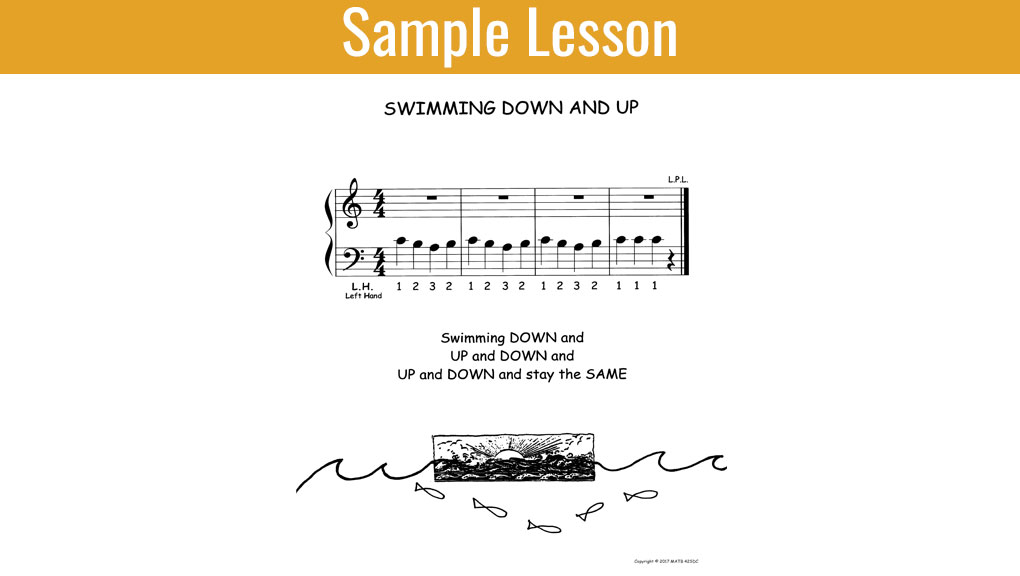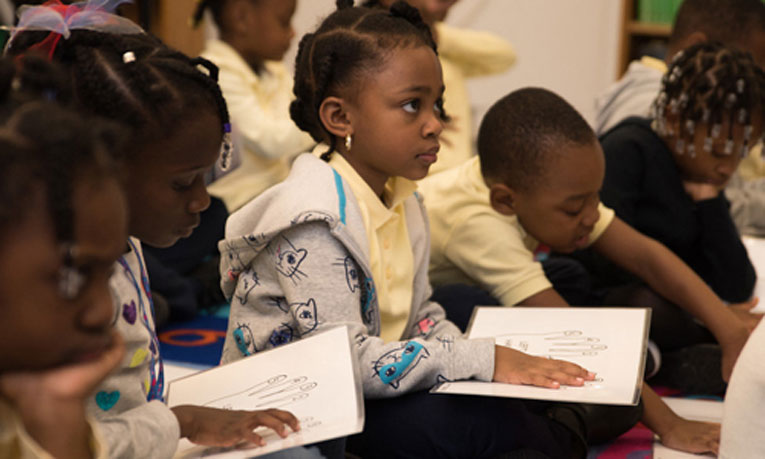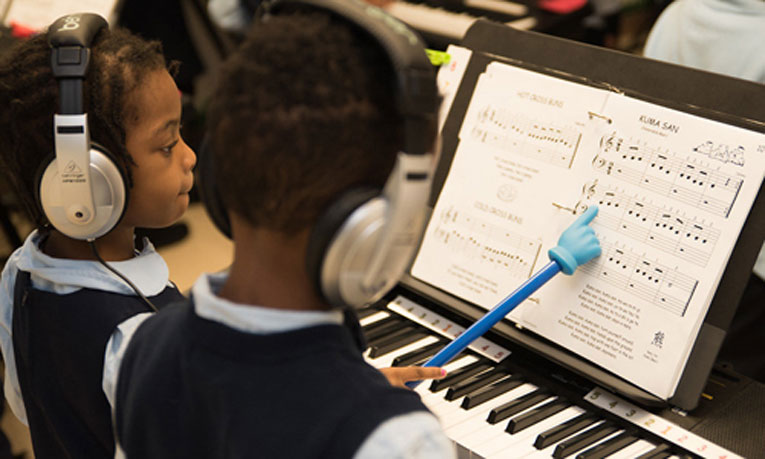

Throughout Music and the Brain Piano Book I, the songs’ melodies are played alternately in each hand with the goal of developing dexterity equally in both. This differs from other piano method books and was done intentionally in following with the goals of this curriculum. We are striving for students to build analytical, cognitive and fine motor skills to help in their overall development.
“Swimming Down and Up” starts the program for all beginners regardless of age. It introduces the three notes in the bass staff (C, B and A) that are played with the three strongest fingers (1, 2 and 3) in the left hand. Beginning students may find this difficult. Do not worry. These notes occur again and again throughout the repertoire and eventually it will become very easy. “Swimming Down and Up” is mated with the next song, “Flying Up and Down,” which is written in the treble clef for the right hand.
“Swimming” also introduces directionality, i.e. the movement of melody up or down on the staff. Pitches have only three ways to move: UP higher, DOWN lower, or REPEAT stay the same. This idea helps to simplify music. Keep it simple for beginning students. Let dexterity be their only real challenge and allow time for that to develop. Be sure to incorporate lots of movement in class during rug time. Have the children move down and move up. Show directionality with your hands and body. Move while singing. Lastly, we are introducing quarter notes and quarter rests in this piece.
Though most children in our program do not have pianos for at-home practice, they can and should leave the class with the songs in their head. This allows them to practice and go over the concepts without even knowing that they are practicing. Everything contributes to their understanding the language of music and to their growing abilities at the keyboard.
1) Quarter notes and quarter rest
2) Directionality: up, down, and stay the same
3) Lines and Spaces/Stepwise motion
4) Bass Clef and staff
5) LH 1 2 3 (do, ti, la is optional)
6) Yellow/lemon left (color coded finger numbers)
7) 4/4 time signature
1) Playing with a steady beat
2) Tracking the pattern
3) Using three fingers
4) Releasing the last C for the quarter rest
5) Stopping the 1-2-3-2 pattern at the end to go to the repeated notes
6) Curved hand position
7) Concentrating on the music without watching fingers
Refer to bass staff/left hand notes as lower than treble staff/right hand notes. Moving to the left on the keyboard is going down and getting lower, and moving to the right on the keyboard is going up and getting higher. Clarify the idea that both hands can move in all directions: up, down and staying the same.
1) Have a student track the notes as the class claps the rhythm of the song with both “tas” and “quarter.”
2) Show students the rhythm cards for the rhythms used in this song and some not used so they can determine what matches.
3) Introduce or review the quarter rest. Say “sh.”
4) Track the notes as the class sings the numbers. Sing the lyrics. Occasionally freeze at a note and see if the students can tell you where you stopped.
5) Discuss and demonstrate going up and down (high and low). Use arms or the entire body. Have a student come up and trace the movement of the drawing of fish and then the notes. Both are moving down and up.
6) Sing the Listening Collection, minus the vocals (after listening to it with the vocals).
7) Practice a nicely curved hand position. Use an analogy like “pretend you are holding a ball or petting a kitten.” Consider practicing on the opposite wrist.
8) Have the children play the song on the laminated keyboard cards (Hand side first and show the At the Piano video).
1) Which measure is different from the others? How is it different?
2) Which hand do you use to play this piece? How did you know? What is the right hand doing?
3) Can you see something in the music that is not a note? What does it look like?
4) Where is the word “Down” and the word “Up” in the music? Which is higher on the staff?
5) What direction does this song begin with? How many times do we ‘swim’ down in this song?
6) Do any of you like/know how to swim? What does it feel like when you swim?
7) What swims? Can animals that are not fish swim?
1) Play this song in a lower or higher register. Ask the difference.
2) Play three notes (that are moving up or down or repeating) and the children identify the direction. Try this with eyes closed and indicate the answer by having their thumbs point up or down.
3) Play a single note, repeat it (1, 2, 3, 4 times), and have students tell you how many times it was played.
4) Sing a single note and have the class sing it back to you. Then sing a note twice, or three times and have them sing that back to you.
5) Sing C-B-A and have the children sing it back. Add on and sing C-B-A-B-C and have the children echo.
6) Sing one note, A, B or C, have the children echo back, and ask if anyone can tell you which note was sung.

Conduct warm ups and consider using the instructional videos and/or recordings to guide the practice. At this stage, it might be best to practice the entire song a few times together as a class; be sure to highlight the number of repetitions, and the quarter rest at the end of the song.
Students should have their headphones off at this stage. Tell students when to put their headphones on, and how many times to play through the piece, marking each time with the clip and number line. Remind students to sing while playing.
1) After individual practice, have the class play along with the accompaniment track (#3).
2) Students may also enjoy trying to play along with the MATB Listening Collection recording. It is in the same key as the book. If not the entire melody, students could play just the last, C-C-C-rest and say the “sh”, repeatedly throughout. It’s a great way to experience playing a jazzy style of piano.
3) At the keyboard lab, or the rug, choose students to perform all or part of the song.
Students now have their headphones on and are practicing independently. Instruct student partner pairs to look for LH hand position (thumb on its side and on C, all fingers on their own keys), to listen for directionality, and to count/track how many times their partner plays the 1-2-3-2/C-B-A-B pattern. (Students may also create and use their own partner checklist.)
IMPROVISATION (Optional)

1) It’s important for students to have had familiarity with the rhythm cards before starting to learn the song. Also, they should have some familiarity with finger numbers and with left hand/right hand.
2) Your hand position when modeling is critical. Model a softly cupped hand, not straight and rigid!
3) Mirroring sometimes takes practice for the teachers. Practice at home with a mirror until you feel comfortable. You will become a pro at this!
4) Copy the music and have students mark the directions of the melody with arrows up and down.
5) Play a simple “Simon Says” using these new concepts; Simon says hold up your left hand, your right hand, your thumbs, move down, move up, stay the same, etc.
6) GAME: Have the children sit in a circle and sing the song (slowly and in time) while passing around a soft object – ideally a stuffed or beanbag fish – on every beat of the song. The passing stops on the last quarter note and whoever would be the rest is out.

Literacy: (For young students) Spell the word S-W-I-M-M-I-N-G. Other related words to teach, spell and, write include: dive, float, paddle, submerge, wade, tread water, boat, ship, submarine, pond, lake, ocean, beach, pool, etc. Alternatively, you can discuss the composer, L.P.L., (Lisha Papert Lercari) and explain what an initial is; have the children write their own initials and/or have the children make up words using these initials.
Math: Have young students count or graph all the line notes and space notes (9 and 6, respectively) and then have them figure out how many more line notes there are than space notes (3). Which measure has these 3 extra line notes? Compare number of fish on the poster to notes and syllables in “swim-ming down and up.”
Social Studies/Geography: Using a map, show the 5 oceans of the world (5 oceans, 5 fingers in each hand is another connection). Discuss why we need oceans to survive as a planet.
Science: Surface waves are caused by wind and impacted by the speed of the wind as well as the gravitational pull on the earth from the sun and the moon (tides or tidal waves). Have students draw either of these two kinds of waves, showing either the wind or sun and moon as the cause.
Book Recommendations
Into the Sea by Brenda Guiberson
Follow the Moon by Stephanie Lisa Tara